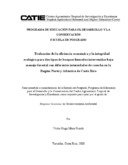Mostrar el registro sencillo del ítem
Evaluación de la eficiencia económica y la integridad ecológica para dos tipos de bosques húmedos intervenidos bajo manejo forestal con diferentes intensidades de cosecha en la Región Norte y Atlántica de Costa Rica
| dc.contributor.advisor | Navarro, Guillermo | |
| dc.contributor.author | Meza Picado, Víctor H | |
| dc.date.accessioned | 2014-10-20T04:57:02Z | |
| dc.date.available | 2014-10-20T04:57:02Z | |
| dc.date.issued | 2008 | es_ES |
| dc.identifier | 372563 | es_ES |
| dc.identifier.uri | https://repositorio.catie.ac.cr/handle/11554/5028 | |
| dc.description | 30 ilus. 15 tab. 29 ref. 112 pág. | es_ES |
| dc.description | Tesis (Mag. Sc.) -- CATIE, 2008 | |
| dc.description.abstract | or for the payment modalities of the national Payments for Environmental Services indicating that an improvement of the most influencing factors for the rentability of sustainable forest management permits that the activity can possibly take place in locations with a high land opportunity cost and forest prices until 3.000.000 {Ostrok}/ha. Se toma como base la caracterización biofísica del bosque después del aprovechamiento y los factores que más peso tienen sobre la rentabilidad y la integridad de los bosques manejados, así como la capacidad de recuperación a partir de la definición de umbrales mínimos que determinen la posibilidad de nuevas cosechas. Donde el bosque es ubicado y tipificado en el contexto del paisaje forestal circundante, lo que permite evaluar el bosque considerando sus características particulares según dos tipos de bosques: el gavilán-palmas y el caobilla-gavilán. Para esto se trata de simplificar una diversidad de factores que influyen en la aceptación social de manejar los bosques sosteniblemente en unos pocos indicadores confrontándose contra la intensidad de cosecha. Se hace necesario generar políticas que influyan en cambiar factores como la tasa de descuento o la manera en el pago por servicios ambientales, lo que demuestra que cuando existe una mejora en los factores que mayor peso tienen sobre la rentabilidad del manejo de bosques la actividad pueda darse aún en lugares de un costo de oportunidad de la tierra alto y precios del bosque de hasta 3.000.000 {Ostrok}/ha. The present investigation is based on the biophysical characterization of forest after it has been harvested. It focuses on the factors that are most relevant for the rentability and integrity of managed forests as well as on the capacity of recuperation departing from the definition of minimum thresholds that define the possibility of new harvests. The forest, being located and classified in its surrounding forest landscape allows for a forest evaluation that acknowledges specific characteristics according to two types of forest: the 'gavilan-palmas' and the 'caobilla-gavilán'. For simplicity, the diversity of factors that influence the social acceptance for sustainable forest management has been limited to a few indicators that are contrasted with harvest intensity. It can be concluded that it will be necessary to generate policies to allow for changes in factors such as the discount rate | es_ES |
| dc.language.iso | es | es_ES |
| dc.publisher | Centro Agronómico Tropical de Investigación y Enseñanza (CATIE) | es_ES |
| dc.relation.ispartof | Maestría en Socioeconomía Ambiental | |
| dc.subject | BOSQUE HUMEDO | |
| dc.subject | PAISAJE | |
| dc.subject | ORDENACION FORESTAL | |
| dc.subject | COSECHA | |
| dc.subject | RENTABILIDAD | |
| dc.subject | COSTA RICA | |
| dc.title | Evaluación de la eficiencia económica y la integridad ecológica para dos tipos de bosques húmedos intervenidos bajo manejo forestal con diferentes intensidades de cosecha en la Región Norte y Atlántica de Costa Rica | es_ES |
| dc.type | Tesis de maestría | es_ES |
Ficheros en el ítem
Este ítem aparece en la(s) siguiente(s) colección(ones)
-
Tesis [2889]


